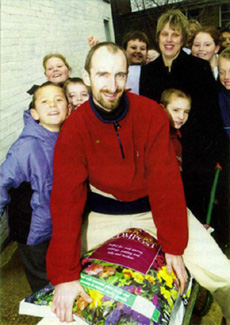

It is always difficult to find partners for teachers who work in the outlying areas of the county. Until Dr. Phil Smith (JIC) agreed to travel the 100+ miles round trip, arranging a partner for Mrs. Maxine Woods, a teacher at Heacham Middle School, was no exception. Maxine had been waiting for over two years.
The partnership began in December 1998. Phil, rather bemused at the partnering process, compared the way TSN selected his teacher partner with the way a contestant on Blind Date makes his/her decision. Nevertheless, it has proved to be an inspired choice; when Maxine and Phil’s first meeting took place, to quote both of them, “we just hit it off immediately”. The instant rapport helped cement the partnership.
In that first term they worked together with Year 6 pupils on planning and implementing investigations, separating techniques and working with microscopes using the TSN kit. But their situation was about to change; Maxine had accepted a new job in Southend-on-Sea (Essex). With both of them keen to keep the partnership going, the only problem was to find financial help to cover travel costs. “Thankfully TSN continued to support us contributing 50% of my expenses,” said Phil “and an approach to the Biotechnology & Biological Science Research Council – my funding body – yielded the other 50% via their Schools’ Liaison Service.”
With the help of Maxine’s head teacher, Jan Watson, the long drive to Southend has been made more effective by putting aside a whole day for each visit. “There are tremendous benefits from being able to work with the same set of pupils for a whole day.” Maxine explained, “A full science day with the children inevitably becomes cross-curricular as you touch on so many different themes during the session. We began with a Cells and DNA Discovery day on Phil’s first visit. We both thought this might have been a bit ambitious for Year 5 but they grasped the basic ideas via an interactive slide show based on the JIC/IFR Cell City production. They built on these with a range of practical activities through-out the day. It was a big success and we hope to develop the slide show into another TSN kit.”
With fewer visits to the school, Phil and Maxine now exchange new ideas via e-mail and telephone, and spend more time planning the days’ science programme in this way. “It’s amazing how much time the planning takes,” said Phil, “but ‘Southend Cell City’ showed me that all the effort can be worthwhile.” Summing up her feelings, Maxine said, “I hadn’t thought I would put so much time into TSN or get so much pleasure out of it. It shows that science can be fun — and if we feel that then the children will too.”
Our “Environmental Science” day was good fun with the children rummaging through bags of rubbish realising just how much waste we generate and how much of it can be recycled. We have also found some very simple activities work well - we organised a day of Investigative Science with pupils planning simple experiments into the properties of materials to design “Santas Sack” and learning to use binocular microscopes by reading shrunken text from Harry Potter. How many times have we all shown kids things under microscopes and not been sure what they are looking at? This is a great way to know they are using the microscope correctly.
Our biggest project was for National Science Week 2001 for which we were awarded a BBSRC NSW grant. We transformed the school (metaphorically speaking) into a home for the day. The children then worked their way around the home during the day looking a different aspect of science associated with each of 6 different rooms: the kitchen, bathroom, dining room, study, workshop and the garden. For example the action of detergents in the kitchen – “scientific washing-up!”